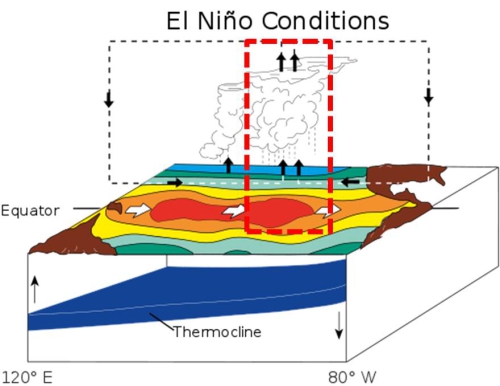Scientists Find a Key Process Affecting Projection of ENSO Sea Surface Temperature
Date:2019-01-28
El Nino–Southern Oscillation (ENSO) is one of the key factors inducing extreme climate events around globe. Projecting the strength change of ENSO sea surface temperature (SST) under global warming is important to understand how the extreme climate events could change under global warming. Unfortunately, all the latest generations of Coupled Model Intercomparison Project (CMIP) in recent decades cannot project a high intermodel agreement change in ENSO SST strength under global warming. The intermodel spread is remarkable relative to the multi-model ensemble mean. It is therefore urgent to trace the possible sources leading to the uncertain ENSO SST change in the state-of-the-art models for improving the models and their projections. However, many complicated processes---including atmospheric, oceanic and air–sea coupled processes---can influence ENSO SST changes.
Recently, a team led by Dr. HUANG Ping from Institute of Atmospheric Physics, CAS and Prof. CHEN Dake from Second Institute of Oceanography, MNR, published their new findings in Journal of Climate, revealing a key process in the models resulting in the uncertain change in ENSO SST strength. In tropics, the response of atmospheric circulation to local SST anomalies is a key process for tropical climate, including ENSO of course. However, large intermodel discrepancies exist in current climate models.
"We found the different response of circulation to SST anomalies among the models is a key process leading to large inter-model spread of the changes in ENSO SST strength.” Said Dr. HUANG.
If the atmospheric circulation response to SST anomalies is relatively more sensitive in one model, this model tends to project a larger decrease in ENSO SST strength. This relationship is statistical significance in 31 CMIP5 models. Because the current models generally overestimate the sensitivity of atmospheric circulation response to SST anomalies compared with the observations, this study – under the consideration of emergent constraint – suggests the ENSO SST in a warmer climate should be strengthened relative to the projection of the multi-model ensemble mean.

Schematic of ENSO. The red box denotes the equatorial central Pacific convection and circulation response to SST anomalies, a key process of ENSO. The state-of-the-art climate models cannot realistically reproduce this process, with large bias relative to the observations and remarkable intermodel discrepancies. This study reveals the defect of this process in climate models is a key reason that these models project an uncertain change in ENSO SST strength under global warming. (Image by NOAA)
This study also implies that more realistic convection and circulation in the models could be an effective way to project more robust changes in ENSO SST strength and global extreme climate events.
Citation: Ying, J, P. Huang, T. Lian, and D. Chen, 2018: Inter-model uncertainty in the change of ENSO's amplitude under global warming: Role of the response of atmospheric circulation to SST anomalies. Journal of Climate, 32, 369–383
https://journals.ametsoc.org/doi/abs/10.1175/JCLI-D-18-0456.1
Media contact: Ms. LIN Zheng, jennylin@mail.iap.ac.cn
